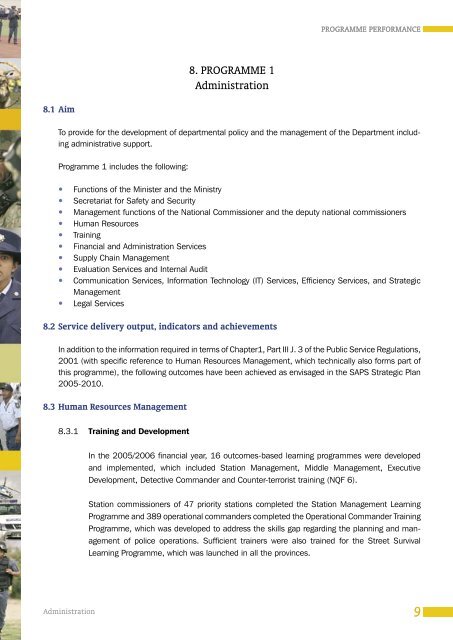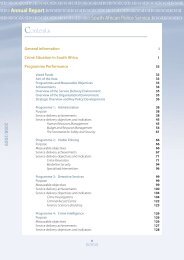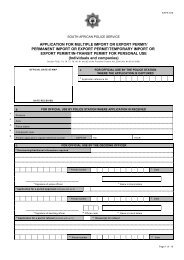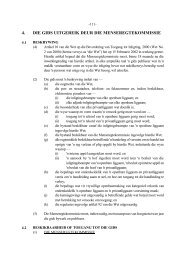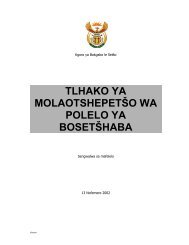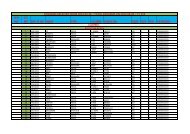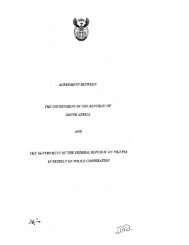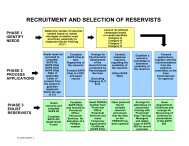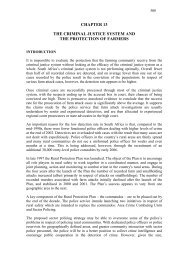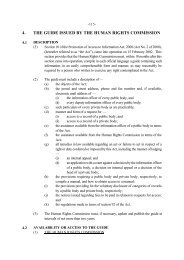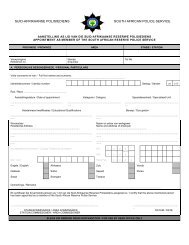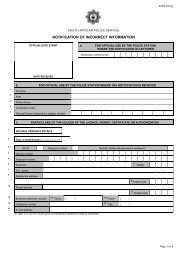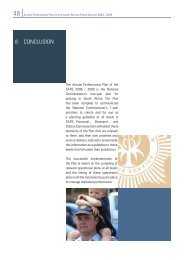Program Performance Program 1 - Saps
Program Performance Program 1 - Saps
Program Performance Program 1 - Saps
You also want an ePaper? Increase the reach of your titles
YUMPU automatically turns print PDFs into web optimized ePapers that Google loves.
8.1 Aim<br />
Administration<br />
8. PROGRAMME 1<br />
Administration<br />
PROGRAMME PROGRAMME PERFORMANCE<br />
To provide for the development of departmental policy and the management of the Department including<br />
administrative support.<br />
<strong>Program</strong>me 1 includes the following:<br />
�<br />
�<br />
�<br />
�<br />
�<br />
�<br />
�<br />
�<br />
�<br />
�<br />
Functions of the Minister and the Ministry<br />
Secretariat for Safety and Security<br />
Management functions of the National Commissioner and the deputy national commissioners<br />
Human Resources<br />
Training<br />
Financial and Administration Services<br />
Supply Chain Management<br />
Evaluation Services and Internal Audit<br />
Communication Services, Information Technology (IT) Services, Efficiency Services, and Strategic<br />
Management<br />
Legal Services<br />
8.2 Service delivery output, indicators and achievements<br />
In addition to the information required in terms of Chapter1, Part III J. 3 of the Public Service Regulations,<br />
2001 (with specific reference to Human Resources Management, which technically also forms part of<br />
this programme), the following outcomes have been achieved as envisaged in the SAPS Strategic Plan<br />
2005-2010.<br />
8.3 Human Resources Management<br />
8.3.1 Training and Development<br />
In the 2005/2006 financial year, 16 outcomes-based learning programmes were developed<br />
and implemented, which included Station Management, Middle Management, Executive<br />
Development, Detective Commander and Counter-terrorist training (NQF 6).<br />
Station commissioners of 47 priority stations completed the Station Management Learning<br />
<strong>Program</strong>me and 389 operational commanders completed the Operational Commander Training<br />
<strong>Program</strong>me, which was developed to address the skills gap regarding the planning and man-<br />
agement of police operations. Sufficient trainers were also trained for the Street Survival<br />
Learning <strong>Program</strong>me, which was launched in all the provinces.<br />
9
Annual Report of the South African Police Service for 2005/2006<br />
10<br />
227 detective commanders completed the Detective Commander Learning <strong>Program</strong>me and 1<br />
138 detectives were also trained in the Detective Learning <strong>Program</strong>me.<br />
1 251 designated Firearms Officers were trained in terms of the need to facilitate the successful<br />
implementation of the Firearms Control Act, 2000 (Act No 60 of 2000).<br />
As part of a special project, 66 reservists of the previously disadvantaged groups obtained their<br />
driver’s licenses, which automatically advantaged their establishment in the SAPS.<br />
The intelligence training presented by the National Intelligence Agency, French Intelligence<br />
Agency and the FBI positively assisted in developing skills to improve intelligence training and<br />
to develop an Advance of Intelligence Learning <strong>Program</strong>me.<br />
As part of women empowerment, more female trainers were developed to present operational<br />
training. Courses were also presented as special projects, specifically to develop female personnel<br />
and emphasis was placed on strategies in the Learning <strong>Program</strong>mes to address crimes<br />
against women and children.<br />
9850 entry-level constables successfully completed the Basic Training Learning <strong>Program</strong>me for<br />
this reporting period. The four additional SAPS Training Institutions that were established during<br />
this period for the purpose of providing basic training are fully functional. Six SAPS Training<br />
Institutions that provided Basic Training, obtained provisional accreditation as a provider from<br />
SASSETA to present the National Certificate in Policing (NQF level 5) which was revised and<br />
registered on the National Qualification Framework. An assessment body was also established<br />
to standardize and manage the examination of the Basic Training Learning <strong>Program</strong>me<br />
(BTLP). Currently, the focus is on the examination of the Basic Training and Detective Learning<br />
<strong>Program</strong>me assessments. 95 personnel that were recruited laterally from other Departments,<br />
received training on the Introductory Police Training Learning <strong>Program</strong>me.<br />
The SAPS contributed to the first unit standard-based degree in Policing in South Africa,<br />
namely the Bachelor degree in Police Practice on NQF level 6. This qualification is the product<br />
of a joint venture between the SAPS, SAQA and SASSETA.<br />
In accordance with the National Skills Development Strategy (NSDS), 41 members finalised<br />
their Occupational Directed-Education Training and Development NQF level 5 Certificate. 13<br />
of the unemployed graduates from the first internship programme obtained permanent positions<br />
and 30 participated in the second internship programme. 10 candidates from tertiary<br />
institutions took advantage of the opportunity to obtain workplace experience and were successful<br />
in obtaining a positive mentorship report to enable them to finalize their qualification.<br />
Funding was provided by SASSETA for the development of a Forensics qualification and the<br />
development of a learnership for detectives, both on NQF level 5.<br />
South Africa attended and hosted SARPCCO courses in order to build capacity for the regional<br />
fight against crime. The SARPCCO Training Committee, with the assistance of the Institute for<br />
Security Studies, secured funding to develop a Police Peacekeeping <strong>Program</strong>me. Assistance<br />
<strong>Program</strong>me 1
Administration<br />
PROGRAMME PERFORMANCE<br />
will also be given to countries that have been and/or will be deploying police officers on peacekeeping<br />
missions to other countries in Africa. The SAPS had 9 of these courses in South<br />
Africa and 312 police officers were trained that can be deployed in peacekeeping missions.<br />
A Regional Dog Breeding and Dog Training Centre is being established at Roodeplaat that will<br />
include the training of explosive dogs, sniffer dogs and dog handler training for SARPCCO countries.<br />
Development assistance was given to the National Police of the Democratic Republic<br />
of Congo (DRC) in order to build capacity to effectively police their national general elections.<br />
Assessment visits were conducted in Sudan and a Development Assistance Framework had<br />
been drawn up in order to provide effective policing assistance to Sudan. Training presented<br />
to African Countries include Operational Commanders Training to the DRC police, Crowd<br />
Management Training to the DRC and Comores, Police and Dog Training to Botswana, Lesotho<br />
and Malawi Police. Assistance in forensic science and detective courses were provided to<br />
members of the Royal Swazi Police.<br />
Foreign donor support was received through the Swedish SIDA Project, to assist in the establishment<br />
of an outcomes based Basic Learning <strong>Program</strong>me. This project entailed the exchange<br />
of best practices between the Swedish and South African Police Services Basic Training<br />
Institutions towards the development of case based and role-play training methodologies.<br />
Through the European Union Capacity Building and Institutional Development <strong>Program</strong>me,<br />
support was provided by means of training in: Adult Basic Education (ABET); Driver Training<br />
(K 53); Emerging Leadership; Executive Development and <strong>Program</strong>me and Project<br />
Management.<br />
Through the Belgium Support <strong>Program</strong>me training was provided in order to build capacity at<br />
station level. The following areas received attention: Crowd Management, Crime Prevention<br />
and Sector Policing. An integrated Station Management <strong>Program</strong>me has also been developed<br />
and implemented at 47 priority crime stations. A Practical Policing Guide has also been developed<br />
in pocket size format and has been issued to all functional police officials.<br />
A Skills Audit process was piloted at 250 stations and involved a total number of 16 228<br />
members. The Workplace Skills Plan (WSP) and Personal Development Plans (PDP’s) were<br />
subsequently developed. A total of 54 329 members received training in terms of the WSP,<br />
which represents 72% of a total of 75 529 for whom training was planned.<br />
8.3.2 Human Resource Planning<br />
The challenge of HR Planning is always to identify the future human resource needs of the<br />
Service and to develop a plan to facilitate the correct resourcing of the Service’s human resources<br />
according to the strategic objectives of the organisation. The allocation priorities of<br />
human resources in the 2005/6 financial year can be highlighted as follows:<br />
An additional 11 000 entry-level constables and 1 000 public service act personnel were<br />
enlisted during the 2005/6 financial year to reach the establishment target of SAPS of<br />
156 060 personnel.<br />
11
Annual Report of the South African Police Service for 2005/2006<br />
12<br />
The 14 presidential and the 169 priority stations were earmarked as a priority in the allocation<br />
criteria. In addition, to comply with the Cabinet priority to implement the proposed<br />
Government Security Service Agency an additional 2 000 entry-level posts were earmarked<br />
for Protection and Security Service services. Borderline Law Enforcement and Security were<br />
allocated 1 000 entry-level personnel for distribution in the respective Provinces responsible<br />
for ensuring Borderline Law Enforcement.<br />
In total 10 802 of the entry-level posts were allocated to Provinces with the main focus to<br />
increase HR capacity on station level.<br />
All business units were provided with Equity profiles to ensure the compliance with Equity ratios<br />
during enlistments and promotion drives.<br />
8.3.3 Career Development<br />
Part of completing the puzzle to ensure and maintain an effective workforce is the process<br />
of ensuring that suitable persons are attracted to be employed by the Service. This means<br />
that the Service should effectively market itself as an employer of choice. Issues which are<br />
giving the SAPS its competitive edge is its total reward strategy, its diversity of occupations,<br />
opportunities of self actualisation and being part of building a Service of professionals striving<br />
for service excellence.<br />
The SAPS has therefor successfully established fully functional Career and Information Centres<br />
in all Provinces. The last 4 fixed Career and Information Centres were launched during the<br />
2005/6 financial year. This initiative complies with a Cabinet priority namely to address poverty<br />
in SA by making the community aware of jobs and career opportunities in SAPS.<br />
The mentioned Career Centres are being utilized to support the objectives of informing and<br />
educating SAPS employees about career opportunities within the organization.<br />
Mobile Career Centres are also fully operational in all provinces and two additional mobile<br />
career centres have been established at National level. The mobile career centres are being<br />
utilized to participate in career fairs, expos, and recruitment drives and programmes with the<br />
main focus to inform recruitment drives in under represented business units and scarce skills<br />
environments.<br />
8.3.4 Labour Relations<br />
The SAPS has previously, together with its social partners, invested in creating a relationship,<br />
which would ensure sound labour relations, labour peace and trust. In order to realise and<br />
maintain such a relationship the framework that regulates the relationship between organised<br />
labour, its members and the employer must be clear and agreed to.<br />
It was found that such clarity was needed and a process was embarked upon to review all<br />
<strong>Program</strong>me 1
Administration<br />
PROGRAMME PERFORMANCE<br />
113 previous agreements reached at the National Negotiation Forum and Safety and Security<br />
Sectoral Bargaining Council (SSSBC). This culminated in a new agreement (2/2005), which<br />
repealed 79 agreements, retained 25 agreements and subjected 9 agreements to a further<br />
review process.<br />
A further agreement (Agreement 3/2005) was concluded in the SSSBC, which reviewed the<br />
Discipline Procedure, Grievance Procedure, Management of Poor <strong>Performance</strong>, Full Time Shop<br />
Stewards, Procedural Agreement and Overtime Remuneration. This agreement is aimed at<br />
achieving the speedy resolution of grievances, the introduction of a single disciplinary regime<br />
for all employees and the management of poor performance. It also revisits the previous<br />
agreements regarding Full Time Shop Stewards, the conditions of release of ordinary shop<br />
stewards and the capping of the overtime rate to be paid to employees.<br />
Testimony to the nature of this relationship, an amount of R30 million was set aside for transformatory<br />
measures. Parties concluded an agreement regarding the utilisation of the transformation<br />
funds. The agreement focuses on three areas, i.e. training, infrastructural development<br />
and the introduction of a computerised case management system. The training interventions<br />
include projects such as Women Empowerment, Discipline Management, Sexual Harassment,<br />
Station Management, Diversity and Service Delivery Improvement. Infrastructural development<br />
focuses on providing water / electricity and assistive devices for people with disabilities to gain<br />
access to police workplaces.<br />
8.3.5 Compensation Management and <strong>Performance</strong> Management<br />
The SAPS has throughout the past years pursued its objective to compensate its personnel in<br />
terms of a total reward strategy. A critical factor within such a strategy is to ensure value for<br />
money, which is measured through performance management. The Service has exceeded its<br />
target of 90% of its employees complying with such systems and achieved a 96% compliance<br />
rate. The fact that compensation practices are based on performance management will sustain<br />
the levels of compliance in the following years. It means that almost all employees could<br />
be considered to receive performance-based rewards or not, based on their performance.<br />
A special dispensation for employees appointed in terms of the SAPS Act was implemented<br />
with effect from 1 April 2005, based on performance. Qualifying members were awarded a<br />
maximum of eight notches (± 8%) within their respective levels over an above the annual<br />
cost-of-living adjustment.<br />
All employees, excluding the Senior Management Service (SMS), received an annual costof-living<br />
adjustment of 4.6%, with effect from 1 July 2005. In addition to the above, members<br />
could also qualify for an additional 1% pay progression based on their performance.<br />
<strong>Performance</strong> was also used to identify those employees who should qualify for both individual<br />
and team incentives. Organizational <strong>Performance</strong> indicators were for the first time used to<br />
identify and reward performing stations. The salary dispensation for Senior Superintendents<br />
(Middle Management Service) was converted from an add-on salary dispensation to a more<br />
13
Annual Report of the South African Police Service for 2005/2006<br />
14<br />
flexible total-cost-to-employer dispensation, which allows these employees the flexibility to<br />
structure their packages.<br />
The SMS received an annual cost-of-living adjustment of 4.6% with effect from the 1st of<br />
January 2006, subject to at least an acceptable performance rating. In addition to the above,<br />
members could also qualify for pay progression, based on their performance over the last two<br />
years.<br />
The South African Police Service conducted an investigation into an appropriate salary and rank<br />
structure for the Service. Following the investigation, an agreement was signed in the SSSBC<br />
(Agreement 2/2006) to change the current 16-level salary structure to a more appropriate<br />
Broad Band Salary Structure. This new salary system was implemented on 1 April 2006.<br />
8.3.6 Employee Assistance Service<br />
The aim of this service is to improve the well being of the SAPS member to enhance their<br />
social, spiritual and psychological functioning. Registered social workers, psychologists, psychometrists,<br />
as well as chaplains render services to members to enhance operational productivity<br />
and work performance. This entails:<br />
�<br />
�<br />
Proactive services including suicide prevention, stress management, colleague sensitivity,<br />
life skills (conflict management, anger, decision making, etc), money management,<br />
substance dependency, trauma debriefing, moral regeneration, marriage enrichment,<br />
Mother’s and Father’s Day, Police Sundays and HIV/Aids.<br />
Reactive services are rendered in short-term intervention processes aimed at enhancing<br />
employees’ social, spiritual and psychological functioning by focusing on psychosocial and<br />
spiritual problems, stress and trauma, suicide, workplace issues, relationship problems,<br />
disability, hospital visits, death and death-related services and HIV/Aids issues.<br />
8.3.7 Corruption and Fraud Prevention<br />
The Corruption and Fraud Prevention Plan for the SAPS, initiated in 2004/2005, was developed<br />
further in 2005/2006. The focus of this development was to align the strategy with the guidelines<br />
of the Department of Public Service and Administration on the minimum anti-corruption<br />
capacity requirements in Departments and organizational components in the Public Service.<br />
A number of areas requiring further development were identified, including the establishment<br />
of an anti-corruption organizational culture in the SAPS, linking anti-corruption initiatives to<br />
risk management and developing and implementing effective detection mechanisms such as<br />
whistle blowing and focused internal auditing.<br />
The Corruption and Fraud Prevention Strategy was included in the SAPS Risk Management<br />
Strategy, as required by the Treasury Regulations 2005. This will facilitate the rollout of the<br />
development of corruption and fraud prevention plans within provinces and divisions.<br />
The implementation of the Corruption and Fraud Prevention Plan focused on improving the<br />
<strong>Program</strong>me 1
Administration<br />
PROGRAMME PERFORMANCE<br />
prevention, detection and investigation of corruption and fraud and limiting the impact of<br />
corruption and fraud on the SAPS. The Strategy is compliant with the National Anti-corruption<br />
Strategy of the Public Service, addresses the resolutions of the National Anti-corruption<br />
Summit held in March 2005, as well as the minimum requirements for establishing an anticorruption<br />
capacity within government departments.<br />
Table 1 reflects the alleged offences in respect of which police members were suspended as<br />
a result of their alleged involvement in corruption-related activities. Over the period 1 April<br />
2005 to 31 March 2006, a total number of 529 police members were suspended. Of these<br />
members, 473 were suspended without salaries and 56 were suspended with salaries.<br />
Table 1: Alleged offences<br />
CRIMINAL CHARGES WITH SALARY WITHOUT SALARY<br />
Aiding an escapee 2 15<br />
Armed robbery - 13<br />
Attempted robbery - 3<br />
Attempted theft of motor vehicle 2 -<br />
Bribery 2 1<br />
Corruption 13 220<br />
Defeating the ends of justice - 62<br />
Extortion 2 15<br />
Fraud 16 39<br />
Intimidation 2 2<br />
Robbery 4 4<br />
Theft 13 99<br />
TOTAL 56 473<br />
8.3.8 Risk Management<br />
The SAPS Risk Management Strategy was developed to facilitate the ability of the SAPS to<br />
achieve its strategic priorities by addressing the factors that may impact negatively on police<br />
performance. The implementation of risk management in the SAPS progressed in accordance<br />
with the SAPS Risk Management Strategy, resulting in the completion of a number of initiatives.<br />
A policy on risk management in the SAPS was developed in line with the Risk Management<br />
Strategy. A Risk Management Implementation Plan setting out a phased approach to the implementation<br />
of risk management in the SAPS over the next three years was also developed.<br />
The focus of the implementation plan was to ensure the establishment of an effective risk<br />
management policy framework. Risk management would then be rolled out to provinces and<br />
divisions, the emphasis being on ensuring full integration with the strategic management process<br />
and individual performance management.<br />
A national, strategic risk register was developed and linked to the strategic policing priorities<br />
15
Annual Report of the South African Police Service for 2005/2006<br />
16<br />
reflected in the SAPS Strategic Plan 2005 to 2010. Deputy national commissioners, divisional<br />
commissioners and senior management were consulted in compiling the national risk register,<br />
which was used to inform the Internal Audit Plan used by the Internal Audit Component.<br />
8.4 Budget and Resource Management<br />
8.4.1 Collection of departmental revenue<br />
Tax revenue<br />
2002/03<br />
ACTUAL<br />
-<br />
2003/04<br />
ACTUAL<br />
-<br />
2004/05<br />
ACTUAL<br />
2005/06<br />
TARGET<br />
- -<br />
2005/06<br />
ACTUAL<br />
%<br />
DEVIATION<br />
FROM<br />
TARGET<br />
- -<br />
Non-tax revenue 86 173 82 269 92 481 82 727 119 282 144,2%<br />
*Sale of goods and services<br />
produced by Department<br />
*Sale of scrap, waste, arms and<br />
other used goods<br />
68 091 66 832 81 468 67 586 116 118 171,8%<br />
18 082 15 437 11 013 15 141 3 164 20,9%<br />
Transfers received - - - - - -<br />
Fines, penalties and forfeits 9 648 3 454 6 179 3 498 6 699 191,5%<br />
Interest, dividends and rent on<br />
land<br />
1 951 2 419 2 005 2 418 1 805 74,6%<br />
Sale of capital assets 2 000 5 820 25 1 135 738<br />
* Other capital assets 2 000 5 820 25 1 135 738 65,0%<br />
Financial transactions in assets<br />
and liabilities<br />
41 481 46 401 68 369 56 913 63 140 110,9%<br />
Total Departmental receipts 141 253 140 363 169 059 146 691 191 664 130,7%<br />
The increased collection of departmental receipts for the period is due to the higher number of<br />
firearm license applications received.<br />
8.4.2 Departmental expenditure<br />
PROGRAMMES<br />
VOTED FOR<br />
2005/06<br />
ROLL-<br />
OVERS AND<br />
ADJUSTMENTS<br />
VIREMENT<br />
TOTAL<br />
VOTED<br />
ACTUAL<br />
EXPENDITURE<br />
VARIANCE<br />
1. Administration 8 235 380 222 983 (362 398) 8 458 363 8 820 760 1<br />
2. Visible Policing 13 691 873 (298 240) 533 310 13 393 633 12 860 323 -<br />
3. Detective Services 4 796 265 - (130 716) 4 796 265 4 926 981 -<br />
4. Crime Intelligence 984 888 21 739 (36 054) 1 006 627 1 042 681 -<br />
4. Protection Services 748 589 77 027 (4 142) 825 616 829 758 -<br />
5. Total 28 456 995 23 509 - 28 480 504 28 480 503 1<br />
(The detailed explanations of the reasons for the in-year adjustments, including virement, are<br />
reflected in the Management Report.)<br />
<strong>Program</strong>me 1
8.4.3 Capital investment, maintenance and asset management plan<br />
Administration<br />
8.4.3.1 Capital investment<br />
Facilities<br />
Police stations completed<br />
since January 2005 Completion date<br />
Western Cape<br />
Melkbosstrand 2005-06-10<br />
Langa 2005-03-17<br />
Northern Cape<br />
Steinkopf 2005-07-21<br />
Aggeneys 2005-12-08<br />
Galeshewe (CSC) 2005-04-14<br />
Free State<br />
Mangaung (Batho) 2005-12-15<br />
Frankfort (Namahadi) 2005-11-14<br />
KwaZulu-Natal<br />
Kwa-Mashu (Presidential police station) 2006-01-15<br />
North West<br />
Temba 2005-02-24<br />
Makau 2005-02-24<br />
Madibogo 2005-03-22<br />
Training colleges (renovations) completed in 2005/2006<br />
Western Cape<br />
Bishop Lavis Training College<br />
Eastern Cape<br />
Graaff-Reinet Training College<br />
Mthatha Training College<br />
Gauteng<br />
Pretoria-West Training College<br />
PROGRAMME PERFORMANCE<br />
Police station to be<br />
erected in 2006/2007 Expected completion date<br />
Eastern Cape<br />
Motherwell (Presidential police station) June 2006<br />
Sulenkama May 2006<br />
Lady Frere (Living quarters) March 2007<br />
Lady Frere (Police station) July 2008<br />
Sterkspruit June 2007<br />
17
Annual Report of the South African Police Service for 2005/2006<br />
18<br />
KwaZulu-Natal<br />
Inanda (Presidential police station) Oct 2006<br />
Ezakeni Aug 2007<br />
Gauteng<br />
Eersterust June 2006<br />
Mamelodi June 2006<br />
Duduza June 2006<br />
Thokoza Oct 2006<br />
Mpumalanga<br />
Pienaar July 2006<br />
Hazyview March 2007<br />
North West<br />
Hebron March 2008<br />
Khuma Jan 2008<br />
Mooifontein Jul 2006<br />
Limpopo<br />
Musina March 2009<br />
Letsitele July 2008<br />
Northern Cape<br />
Kuruman Apr 2007<br />
Western Cape<br />
Saron June 2006<br />
Hout Bay July 2006<br />
Blue Downs July 2007<br />
Free State<br />
Verkykerskop Nov 2006<br />
Construction of police stations to commence in 2006/2007<br />
Police station Expected commencement date<br />
Western Cape<br />
Paarl East June 2006<br />
Saldanha Aug 2006<br />
KwaZulu-Natal<br />
Ceza Nov 2006<br />
Nsuze Nov 2006<br />
Gauteng<br />
Tsakane Sept 2006<br />
Diepsloot Sept 2006<br />
Kagiso July 2006<br />
Tembisa Oct 2006<br />
North West<br />
Klipgat Nov 2006<br />
Dubbe Nov 2006<br />
<strong>Program</strong>me 1
Administration<br />
Amalia Oct 2006<br />
Jouberton Nov 2006<br />
Mpumalanga<br />
Ermelo Aug 2006<br />
Mbuzini Oct 2006<br />
Free State<br />
Thabong (Presidential police station) Oct 2006<br />
Zamdela Oct 2006<br />
Limpopo<br />
Masoyi July 2007<br />
Ga Masemola Oct 2006<br />
Matoks Aug 2006<br />
Jane Furse Aug 2006<br />
Eastern Cape<br />
Cradock Oct 2006<br />
Mdantsane NU 1 (Presidential police station) Aug 2006<br />
Debenek Oct 2006<br />
Bisho May 2006<br />
Lusikisiki Nov 2006<br />
Northern Cape<br />
Augrabies (CSC) Oct 2006<br />
8.4.3.2 Maintenance<br />
Facilities<br />
Day–to-day maintenance<br />
PROGRAMME PERFORMANCE<br />
The expenditure for day-to-day maintenance for the 2005/2006 financial year was<br />
R146 908 659<br />
8.4.3.3 Asset management<br />
Vehicles<br />
The following number of vehicles were disposed of/boarded in the respective provinces:<br />
PROVINCE 2004/2005 2005/2006<br />
Eastern Cape 211 600<br />
Free State 253 136<br />
Gauteng 709 783<br />
KwaZulu-Natal 482 423<br />
Limpopo 306 413<br />
19
Annual Report of the South African Police Service for 2005/2006<br />
20<br />
PROVINCE 2004/2005 2005/2006<br />
Mpumalanga 123 285<br />
Head Office 0 431<br />
North West 477 439<br />
Northern Cape 154 123<br />
Western Cape 326 423<br />
TOTAL 3041 4056<br />
PROVINCE<br />
NB: These vehicles were disposed of as a result of normal wear and tear.<br />
The vehicle distribution per province and the age analysis of the vehicles were as<br />
follows:<br />
0-50 000 KM<br />
50 000-<br />
100 000 KM<br />
100 000-<br />
160 000 KM<br />
160 000-<br />
200 000 KM<br />
OVER<br />
200 000 KM<br />
TOTAL<br />
MAR MAR MAR MAR MAR MAR MAR MAR MAR MAR MAR MAR<br />
2005 2006 2005 2006 2005 2006 2005 2006 2005 2006 2005 2006<br />
EASTERN CAPE 1 160 1 043 753 882 783 878 431 476 899 925 4 026 4 204 4,42%<br />
FREE STATE 801 697 488 541 444 514 255 284 415 480 2 403 2 516 4,70%<br />
GAUTENG 1 771 1 883 1 596 1 378 1 555 1 724 853 884 1357 1 535 7 132 7 404 3,81%<br />
KWAZULU-NATAL 1 405 1 341 997 1 017 1 008 1 164 608 614 1113 1 086 5 131 5 222 1,77%<br />
LIMPOPO 702 670 421 455 434 499 280 264 588 656 2 425 2 544 4,90%<br />
MPUMALANGA 474 512 339 302 296 385 184 215 466 504 1 759 1 918 9,03%<br />
HEAD OFFICE 1 063 1 270 471 625 434 490 226 258 315 336 2 509 2 979 18,73%<br />
NORTH WEST 692 638 516 514 525 602 296 347 702 732 2 731 2 833 3,73%<br />
NORTHERN CAPE 305 333 265 272 210 300 121 133 185 221 1 086 1 259 15,90%<br />
WESTERN CAPE 1172 1095 876 875 791 961 448 529 944 1 079 4 231 4 539 7,27%<br />
TOTAL 9 545 9 482 6 722 6 861 6 480 7 517 3 702 4 004 6 984 7 554 33 433 35 418 5,93%<br />
Facilities<br />
31 properties were handed back to the Department of Public Works for further<br />
disposal.<br />
Expert Services continuously conducted audits to ensure data integrity on the system<br />
and issued final certificates for police stations/buildings, which had been completed<br />
within the reporting period. The Assets Register was received from the Department of<br />
Public Works for the internal verification of state-owned and leased facilities in preparation<br />
of the devolution of functions from 1 April 2006 to client departments. The<br />
budgets to be devolved include leaseholds, municipal services and accommodation<br />
charges; the latter will provide for maintenance, property rates and taxes.<br />
A task team was established to visit the various provinces to ascertain the condition/<br />
state of the buildings used by the SAPS.<br />
INCREASE<br />
<strong>Program</strong>me 1
Administration<br />
PROGRAMME PERFORMANCE<br />
No facilities were closed down or downgraded in the 2005/2006 financial year.<br />
Work began on the development of a computerized system that will prioritize day-today<br />
maintenance projects. A task team was established to visit provinces to ascertain<br />
the state/condition of buildings used by the SAPS. The CSIR was also appointed to<br />
give advice/guidance on the development of the computerized system, as well as<br />
the devolution of functions from the Department of Public Works to the SAPS. SAPS<br />
Information and System Management (ISM) and SITA will also form part of the development<br />
process.<br />
8.4.4 Information Systems and Information and Communication Technology (IS/ICT) Resources<br />
Strategy<br />
Information Management of the SAPS will implement its IS/ICT Resources Strategy and Plan<br />
over several years. There are three operational focus areas. The first focus area aims at modernizing<br />
and expanding the number of personal computers, printers and fax machines. The<br />
second focus area concerns the modernization and expansion of the hosting capabilities and<br />
network infrastructure provided by Information Management.<br />
These first two focus areas will pave the way for successfully engaging the third focus area,<br />
which entails the implementation of a range of strategic initiatives aimed at leveraging the<br />
full potential of information systems and information and communication technologies. These<br />
initiatives will ensure improved service delivery by the SAPS to the community and streamlined,<br />
expeditious and cost-effective back-end administration and decision-making.<br />
�<br />
Modernization and expansion of end user equipment<br />
End user equipment deployments: The SAPS continued its intensified efforts to modernize<br />
and expand its end user equipment. To this end, 35 890 items of end user equipment<br />
were deployed in the course of the 2005/2006 financial year. 29 358 (82%) of these<br />
items were deployed at provincial level where they impacted most on the SAPS front-end<br />
service delivery. These items consisted of 14 079 desktop computers, 1 315 notebooks,<br />
10 801 printers and 4 863 items of end user equipment such as digital projectors, digital<br />
video cameras, digital cameras and memory sticks.<br />
Secure USB tokens: 706 USB tokens were purchased for use in the SAPS Crime Intelligence<br />
environment. This technology will secure data on notebooks and work stations by operating<br />
in conjunction with the file security software previously deployed in the Crime Intelligence<br />
environment.<br />
Digital projectors for training facilities: ISM equipped 185 SAPS training rooms with digital<br />
projectors to enhance SAPS training courses and ensure a more effective transfer of<br />
knowledge to trainees.<br />
21
Annual Report of the South African Police Service for 2005/2006<br />
22<br />
�<br />
�<br />
End user equipment for training facilities: ISM equipped five new training colleges with end<br />
user equipment and a network infrastructure, enabling these training colleges to provide<br />
more effective and successful training.<br />
Disabled persons: ISM provided 119 desktop computers and specialized software for use<br />
by disabled persons in the SAPS.<br />
Blackberry: ISM provided 100 Blackberry devices to detectives in a pilot scheme aimed at<br />
investigating whether this improved their ability to deal with complaints and communicate<br />
and collaborate with prosecutors and the general public.<br />
Modernization and expansion of network and hosting infrastructure<br />
The SAPS further increased and enhanced its mainframe storage and processing capacity<br />
in order to cope with the rapidly growing volumes of data transfer and transactions. This<br />
resulted from the continuous growth in the volumes of information used and required by<br />
the information systems, as well as the further implementation of information systems to<br />
previously disadvantaged communities in the Eastern Cape in particular.<br />
Replacement of magnetic tape robotic system: In order to minimize the risk of losing its<br />
corporate systems and subsequent data, the SAPS replaced the outdated magnetic tape<br />
robotic system used at Numerus. This was critical to ensure quality-assured backups for the<br />
corporate systems of the SAPS.<br />
Mainframe processor upgrade: The continuous growth in the volume of SAPS corporate<br />
system transactions, as well as the number of connected work stations and notebooks<br />
necessitated the upgrading of the present processing power capacity of the SAPS. To this<br />
end, the SAPS is continuously investing substantial amounts to keep the processing power<br />
updated.<br />
Server expansions: The SAPS procured an additional 170 servers to establish the infrastructure<br />
for deploying new network authentication capabilities, as well as for expanding<br />
and improving on its email, anti-virus capacity and solutions such as the Firearms Control<br />
System.<br />
SAPS Network Upgrade <strong>Program</strong>me: The SAPS invested a substantial amount to upgrade<br />
the network infrastructure nationally. The entire KwaZulu-Natal network infrastructure was<br />
upgraded and the SAPS is in the process of upgrading the networks in the Eastern Cape<br />
and Gauteng.<br />
Identification capability enhancements<br />
Crime intelligence and Information Analysis Solution: The SAPS enhanced its crime intelligence<br />
capabilities by procuring various technical solutions. These solutions proved to be effective<br />
in supporting intelligence and investigation officials to identify, analyse, consolidate<br />
and understand complex sets of seemingly unrelated data during intelligence processing,<br />
criminal investigations and court preparations.<br />
<strong>Program</strong>me 1
�<br />
Administration<br />
PROGRAMME PERFORMANCE<br />
Geographical Information System: The SAPS maintained and enhanced the Geographical<br />
Information System (GIS) at 340 priority police stations. This capability is in the process of<br />
being further enhanced in that satellite images are being procured that will assist with crime<br />
prevention activities, especially in rural areas where there are no physical addresses. In addition,<br />
the incidence of crime and crime patterns can now be identified and presented on<br />
geographical maps and aerial photographs, providing a very clear, realistic and informative<br />
perspective of crime trends.<br />
Gun control: The SAPS continued its intensified efforts to prevent the proliferation of illegal<br />
firearms and to remove them from society. A comprehensive firearms control information<br />
system is being continuously developed and enhanced. The gun control information system<br />
will automate the processing and screening of firearm license applications and support the<br />
administrative control of legally owned firearms. The first module of the newly developed<br />
Firearms Control System, namely the Firearms Permit System Module is being deployed to<br />
address the issuing of permits to members of the SAPS.<br />
Crime Administration System (CAS): The SAPS maintained and enhanced the CAS. The<br />
remaining 25 police stations in the Eastern Cape where CAS has not been implemented<br />
as a result of difficulties regarding electricity and infrastructure will be addressed in the<br />
2006/2007 and 2007/2008 financial years. The SAPS intends procuring generators and<br />
V-Sat connectivity for these stations to ensure that the system is implemented successfully.<br />
The implementation of CAS contributed to crime trends being identified and crimes<br />
throughout South Africa being linked.<br />
IBIS: The SAPS maintained and enhanced the Integrated Ballistics Identification System at<br />
the Forensic Science Laboratory. This system enables the SAPS to link firearms with specific<br />
crime scenes and cases.<br />
Ports of entry: The SAPS improved the information technology capabilities at the major<br />
border posts. Outdated equipment was replaced at 60 different offices located at ports of<br />
entry. A total of 163 personal computers and 163 dot matrix printers were installed. New<br />
ICT containers were placed at 11 ports of entry and the infrastructure was upgraded with<br />
the latest technology. At seven of the ports of entry a monitoring system was installed to<br />
monitor the entry of containers/ICT rooms by personnel. This includes Durban International<br />
Airport, Cape Town, Johannesburg International Airport and Lanseria Airport.<br />
Information Systems Developments<br />
Exhibits management in FSL: Systems were deployed at the Pretoria, Cape Town and<br />
KwaZulu-Natal laboratories to ensure the effective management of drugs as exhibits.<br />
E-docket: The SAPS procured a comprehensive and cost-effective Electronic Content<br />
Management Solution (ECMS), namely, Documentum to facilitate the creation of electronic<br />
dockets, among other things. This solution will enable the scanning of dockets, which will<br />
prevent information being lost as a result of lost, sold, or stolen dockets.<br />
23
Annual Report of the South African Police Service for 2005/2006<br />
24<br />
�<br />
Biometric Identification and Enhancement Solutions: A capacity was established within the CRC<br />
for identifying and enhancing biometrics. Biometrics previously undetectable with the naked<br />
eye can now be identified and enhanced to identify the perpetrators of crime. Elements of this<br />
solution, namely V+V software, were also procured to scan folien images and keep a record of<br />
any enhancements for evidential purposes. This solution was implemented as a result of the<br />
phasing out of old analogue cameras and the non-availability of the photographic paper used<br />
in the past.<br />
Digital Cameras: Following the phasing out of analogue cameras, the SAPS procured a substantial<br />
number of digital cameras to help detectives investigate crime. The risk attached to the<br />
cameras used previously and the non-availability of spools of film, as well as the loss of images<br />
due to traditional development methods has now been eliminated.<br />
Live Scan: Live Scanning devices were procured in order to capture fingerprints electronically.<br />
This capability enables the SAPS to verify the quality of the fingerprints at local level, reducing<br />
the administrative burden of managing the rectification of unusable fingerprints experienced<br />
with the manual process. It also eliminates the use of ink and paper, as well as cleaning material<br />
needed in the manual process.<br />
Mobile Connectivity Devices (MCD): A mobile Connectivity Capability was procured and implemented<br />
at inter alia ports of entry. It was also implemented within the drug laboratories for<br />
managing exhibits.<br />
Information Systems and Information Communications Technology (IS/ICT) Security Policy and<br />
Standards<br />
The DoSS Information System and Information Communications Technology (IS/ICT) Security<br />
Policy and Standards document, which had been approved on 1 July 2002, was reviewed<br />
and is currently being revised. The review and revised process is necessary to ensure that<br />
security policies are in line with business objectives, information security requirements, information<br />
security legislation, regulations and government guidelines, as well as best practices<br />
and international standards (e.g. Minimum Information Security Standards (MISS): British<br />
Standard Institute (BS7799) Standard for Information Security Management, which has been<br />
adopted by the South African Bureau of Standards (SABS) as the new Code of Practice for<br />
Information Security Management: SABS ISO/IEC 17799; and Information Security Forum’s<br />
(ISF) Standards of Good Practice). Compliance with at least the following information security<br />
legislation, regulations and government guidelines must be established:<br />
King Commission II Report on Corporate Governance for South Africa, 26 March 2002<br />
Electronic Communications and Transactions Act, No.25 of 2002<br />
Interception and Monitoring Prohibition Act, No.127 of 1992<br />
Protection and Information Act, No. 84 of 1982<br />
Promotion of Access to Information Act (PROATIA), 2000<br />
Regulation of Interception of Communications and Provision of Communication-related<br />
Information Act, 2002<br />
<strong>Program</strong>me 1
Administration<br />
PROGRAMME PERFORMANCE<br />
The scope of the revised Doss IS/ICT Security Policies includes the overall security policies,<br />
having the fundamental aim of emphasizing the importance of information, security risk management,<br />
security measures and information security management and control, as well as of<br />
serving as the preface to the various parts of security policies that address specific areas of<br />
security measures, namely:<br />
Part-I: Draft descriptions for security policies<br />
Part-II: Personnel security measures<br />
Part-III: Physical and environmental security measures<br />
Part-IV: Document information asset security measures<br />
Part-V: Systems process security measures<br />
Part-VI: Logical security measures<br />
The revised DoSS IS/ICT Security Policies will provide high-level statements of security concepts,<br />
control and expectations required to protect Doss information systems (i.e. applications<br />
and infrastructure) and resources (including data/information and people) against potential accidental<br />
or intentional security risks (which is the probability of threats exploiting vulnerabilities<br />
creating an impact on the organization).<br />
25


